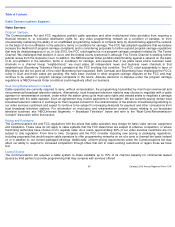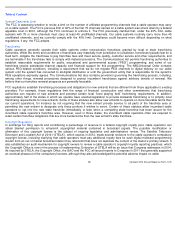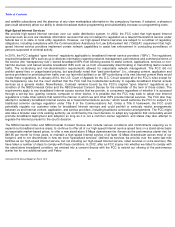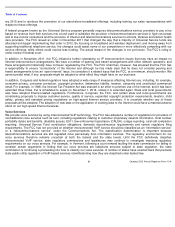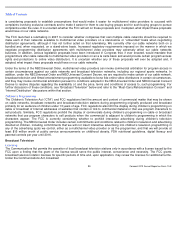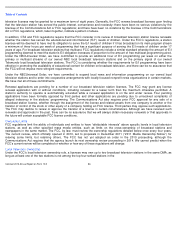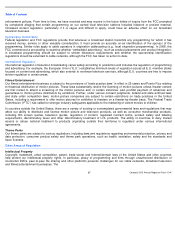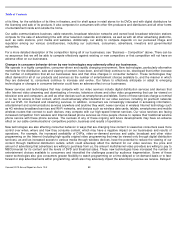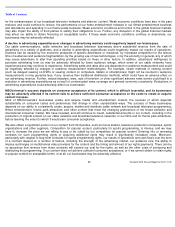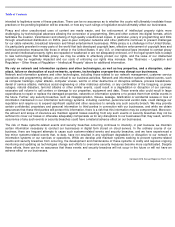Comcast 2013 Annual Report Download - page 32
Download and view the complete annual report
Please find page 32 of the 2013 Comcast annual report below. You can navigate through the pages in the report by either clicking on the pages listed below, or by using the keyword search tool below to find specific information within the annual report.
Table of Contents
enforcement policies. From time to time, we have received and may receive in the future letters of inquiry from the FCC prompted
by complaints alleging that certain programming on our owned local television stations included indecent or profane material.
Increased content regulation, particularly if it is vague and difficult to apply, could have an adverse effect on our broadcast
television business.
Sponsorship Identification
Federal legislation and FCC regulations provide that whenever a broadcast station transmits any programming for which it has
received money, service or other valuable consideration, it must provide an accurate on-
air identification of the sponsor of the
programming. Similar rules apply to cable operators in origination cablecasting (e.g., local origination programming). In 2008, the
FCC commenced a proceeding to examine whether “embedded advertising,”
such as product placements and product integration,
in broadcast programming should be subject to stricter disclosure requirements and whether the sponsorship identification
regulations should be extended to cable networks, although the FCC has taken no action to date.
International Regulation
International regulation of television broadcasting varies widely according to jurisdiction and includes the regulation of programming
and advertising. For example, the European Union (“E.U.”)
establishes minimum levels of regulation across all E.U. member states
focused on content and advertising, which also extends to nonlinear television services, although E.U. countries are free to impose
stricter regulation in certain areas.
Filmed Entertainment
Our filmed entertainment business is subject to the provisions of “trade practice laws”
in effect in 25 states and Puerto Rico relating
to theatrical distribution of motion pictures. These laws substantially restrict the licensing of motion pictures unless theater owners
are first invited to attend a screening of the motion pictures and, in certain instances, also prohibit payment of advances and
guarantees to motion picture distributors by exhibitors. Further, under various consent judgments, federal and state antitrust laws
and state unfair competition laws, motion picture companies are subject to certain restrictions on trade practices in the United
States, including a requirement to offer motion pictures for exhibition to theaters on a theater-by-
theater basis. The Federal Trade
Commission (“FTC”) has called for stronger industry safeguards applicable to the marketing of violent movies to children.
In countries outside the United States, there are a variety of existing or contemplated governmental laws and regulations that may
affect our ability to distribute and license motion picture and television products, as well as consumer merchandise products,
including film screen quotas, television quotas, regulation of content, regulated contract terms, product safety and labeling
requirements, discriminatory taxes and other discriminatory treatment of U.S. products. The ability of countries to deny market
access or refuse national treatment to products originating outside their territories is regulated under various international
agreements.
Theme Parks
Our theme parks are subject to various regulations, including laws and regulations regarding environmental protection, privacy and
data protection, consumer product safety and theme park operations, such as health, sanitation, safety and fire standards and
liquor licenses.
Other Areas of Regulation
Intellectual Property
Copyright, trademark, unfair competition, patent, trade secret and Internet/domain laws of the United States and other countries
help protect our intellectual property rights. In particular, piracy of programming and films through unauthorized distribution of
counterfeit DVDs, peer-to-
peer file sharing and other platforms presents challenges for our cable networks, broadcast television
and filmed entertainment businesses. The
27
Comcast 2013 Annual Report on Form 10
-
K


